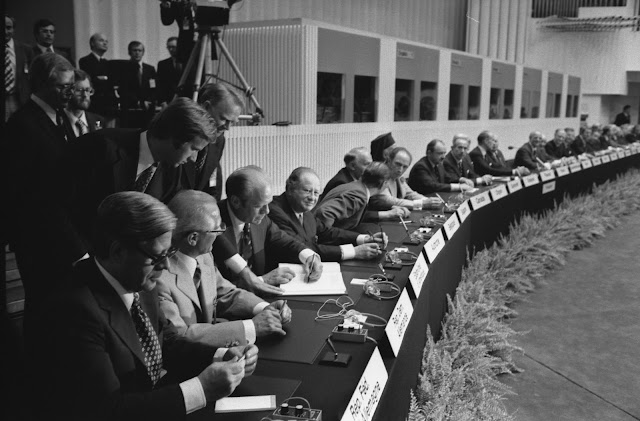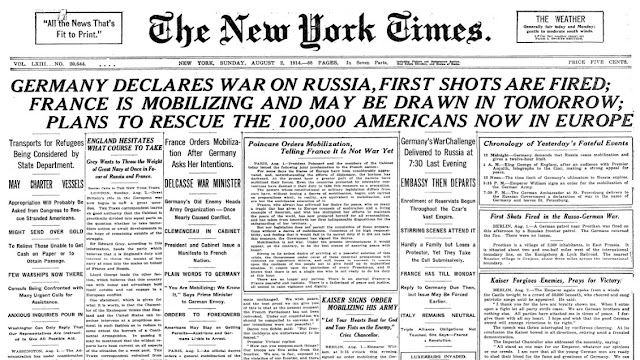On August 1, 1975, the United States, the Soviet Union, Canada and every European nation (except Albania) sign the Helsinki Final Act on the last day of the Conference on Security and Cooperation in Europe (CSCE). The act was intended to revive the sagging spirit of detente between the Soviet Union and the United States and its allies.
During Richard M. Nixon’s presidency, he and National Security Adviser Henry Kissinger fashioned a foreign policy toward the Soviet Union that came to be known as “detente”–literally, a lessening of tensions between Russia and America. The policy enjoyed some success during the early 1970s, as Nixon visited the Soviet Union and discussions about arms reduction began. By the summer of 1975, however, the spirit of detente was flagging. Nixon resigned in disgrace in August 1974 over the Watergate scandal. The United States withdrew from Vietnam without securing victory; in April 1975, South Vietnam fell to communist forces. Progress on arms reduction talks with the Soviets came to a standstill. In July 1975, however, the Soviet Union and the United States attempted to reinvigorate the policy of detente by calling the CSCE in Helsinki. On August 1, the attendees signed the Helsinki Final Act. The act established the CSCE as an ongoing consultative organization, and set out a number of issues (grouped together in what came to be known as “baskets”) to be discussed in the coming months and years. These included economic and trade issues, arms reduction, and the protection of human rights.
For a brief moment, detente seemed to have been revived, but the CSCE soon became the cause for heated debates between the United States and the Soviet Union, primarily over the issue of human rights in Russia. After the signing of the Helsinki Final Act, dissidents and reformers in the Soviet Union formed what was known as the Helsinki Group, a watchdog organization to monitor the Russian government’s adherence to the protection of human rights. The Soviets crushed the Helsinki Group, arresting many of its top leaders. Human rights groups in the United States and elsewhere loudly protested the Soviet actions. The U.S. government criticized the Russians for not adhering to the spirit of the Helsinki agreement. The Soviets resented what they referred to as intrusions into their domestic matters. By mid-1978, the CSCE ceased to function in any important sense. It was revived by Soviet leader Mikhail Gorbachev in the 1980s, and served as a foundation for his policy of closer and friendlier relations with the United States.
On August 1, 1914, four days after Austria-Hungary declared war on Serbia, Germany and Russia declare war against each other, France orders a general mobilization, and the first German army units cross into Luxembourg in preparation for the German invasion of France. During the next three days, Russia, France, Belgium and Great Britain all lined up against Austria-Hungary and Germany, and the German army invaded Belgium. The “Great War” that ensued was one of unprecedented destruction and loss of life, resulting in the deaths of some 20 million soldiers and civilians.
On June 28, 1914, in an event that is widely regarded as sparking the outbreak of World War I, Archduke Franz Ferdinand, heir to the Austro-Hungarian empire, was shot to death with his wife by Bosnian Serb Gavrilo Princip in Sarajevo, Bosnia. Ferdinand had been inspecting his uncle’s imperial armed forces in Bosnia and Herzegovina, despite the threat of Serbian nationalists who wanted these Austro-Hungarian possessions to join newly independent Serbia. Austria-Hungary blamed the Serbian government for the attack and hoped to use the incident as justification for settling the problem of Slavic nationalism once and for all. However, as Russia supported Serbia, an Austria-Hungary declaration of war was delayed until its leaders received assurances from German leader Kaiser Wilhelm II that Germany would support their cause in the event of a Russian intervention.
On July 28, Austria-Hungary declared war on Serbia, and the tenuous peace between Europe’s great powers collapsed. On July 29, Austro-Hungarian forces began to shell the Serbian capital of Belgrade, and Russia, Serbia’s ally, ordered a troop mobilization against Austria-Hungary. France, allied with Russia, began to mobilize on August 1. France and Germany declared war against each other on August 3. After crossing through neutral Luxembourg, the German army invaded Belgium on the night of August 3-4, prompting Great Britain, Belgium’s ally, to declare war against Germany.
For the most part, the people of Europe greeted the outbreak of war with jubilation. Most patriotically assumed that their country would be victorious within months. Of the initial belligerents, Germany was most prepared for the outbreak of hostilities, and its military leaders had formatted a sophisticated military strategy known as the “Schlieffen Plan,” which envisioned the conquest of France through a great arcing offensive through Belgium and into northern France. Russia, slow to mobilize, was to be kept occupied by Austro-Hungarian forces while Germany attacked France.
The Schlieffen Plan was nearly successful, but in early September the French rallied and halted the German advance at the bloody Battle of the Marne near Paris. By the end of 1914, well over a million soldiers of various nationalities had been killed on the battlefields of Europe, and neither for the Allies nor the Central Powers was a final victory in sight. On the western front, the battle line that stretched across northern France and Belgium, the combatants settled down in the trenches for a terrible war of attrition.
In 1915, the Allies attempted to break the stalemate with an amphibious invasion of Turkey, which had joined the Central Powers in October 1914, but after heavy bloodshed the Allies were forced to retreat in early 1916. The year 1916 saw great offensives by Germany and Britain along the western front, but neither side accomplished a decisive victory. In the east, Germany was more successful, and the disorganized Russian army suffered terrible losses, spurring the outbreak of the Russian Revolution in 1917. By the end of 1917, the Bolsheviks had seized power in Russia and immediately set about negotiating peace with Germany. In 1918, the infusion of American troops and resources into the western front finally tipped the scale in the Allies’ favor. Bereft of manpower and supplies and faced with an imminent invasion, Germany signed an armistice agreement with the Allies in November 1918.
World War I was known as the “war to end all wars” because of the great slaughter and destruction it caused. Unfortunately, the peace treaty that officially ended the conflict, the Treaty of Versailles of 1919, forced punitive terms on Germany that destabilized Europe and laid the groundwork for World War II.
On August 1, 1944, Anne Frank, the young Jewish girl hiding out in Nazi-occupied Holland whose diary came to serve as a symbol of the Holocaust, writes her final entry three days before she and her family are arrested and placed in concentration camps.
Frank, 15 at the time, received the diary on her 13th birthday, writing in it faithfully during the two years she and seven others (including her parents, Otto and Edith, and sister, Margot; her father’s business associate Hermann van Pels, his wife, Auguste, and son, Peter; and Fritz Pfeffer, the dentist of Otto Frank’s secretary) lived in a secret annex behind her father’s business in Amsterdam during World War II.
In her final entry, Frank wrote of how others perceive her, describing herself as “a bundle of contradictions.” She wrote:
“As I’ve told you many times, I’m split in two. One side contains my exuberant cheerfulness, my flippancy, my joy in life and, above all, my ability to appreciate the lighter side of things. By that I mean not finding anything wrong with flirtations, a kiss, an embrace, an off-color joke. This side of me is usually lying in wait to ambush the other one, which is much purer, deeper and finer. ….”
She continued that what she says is not what she feels, which is why, in her words, she had a reputation for being “boy-crazy as well as a flirt, a smart aleck and a reader of romances.”
“The happy-go-lucky Anne laughs, gives a flippant reply, shrugs her shoulders and pretends she doesn’t give a darn. The quiet Anne reacts in just the opposite way. If I’m being completely honest, I’ll have to admit that it does matter to me, that I’m trying very hard to change myself, but that I'm always up against a more powerful enemy.”
Of the eight prisoners, Otto Frank was the only survivor. Anne Frank died in 1945 from typhus at Germany’s Bergen-Belsen concentration camp. Her diary was published by her father in 1947; it has since become a worldwide bestseller.
On August 1, 1943, 177 B-24 bombers take off from an Allied base in Libya, bound for the oil-producing city Ploiești, Romania, nicknamed “Hitler’s gas station.” The daring raid, known as Operation Tidal Wave, resulted in five men being awarded the Medal of Honor, three of them posthumously, but failed to strike the fatal blow its planners had intended.
Operation Tidal Wave began ominously, with an overloaded bomber crashing shortly after takeoff and another plunging into the Adriatic Sea. 167 of the original 177 bombers made it to Ploiești, whose oil fields and refineries provided the Germans with over 8.5 million tons of oil per year. Whereas most Allied bombing in World War II was carried out from a high altitude, the bombers that raided Ploiești flew exceptionally low in order to evade the Germans’ radar. The bombers lost the element of surprise, however, when one group veered off on the wrong direction, forcing the others to break radio silence in order to direct them back on course. This unplanned adjustment also led to the bombers approaching from the south, where the Nazis had concentrated their anti-aircraft batteries.
The ensuing attack was dramatic, chaotic and costly. The Allies suffered heavy casualties, and smoke from the explosions caused by the first wave of bombers made visibility difficult for subsequent waves. Survivors reported debris like branches and barbed wire hitting and even ending up on the inside of their planes. Lt. Col. Addison Baker and Maj. John Jerstad were awarded the Medal of Honor for their (unsuccessful) attempt to fly higher and allow the crew to bail of our their badly damaged plane. Another pilot, Lt. Lloyd Herbert Hughes, also received a posthumous Medal of Honor for flying his critically-damaged B-24 into its target. Col. John Kane and Col. Leon Johnson, who each led bombing groups that reached their targets, were the only men who were awarded the Medal of Honor and survived the raid.
Although the Allies estimated that the raid had reduced Ploiești’s capacity by 40 percent, the damage was quickly repaired and within months the refineries had outstripped their previous capacity. The region continued to serve as “Hitler’s gas station” until the Soviet Union captured it in August of 1944. 310 airmen died, 108 were captured and another 78 were interned in neighboring Turkey. 88 of the original 177 B-24s returned, most of them seriously damaged. Despite setting the record for most Medals of Honor awarded to airmen in a single mission, Operation Tidal wave was never repeated, the Allies never again attempted a low-altitude assault against German air defenses.












No comments:
Post a Comment